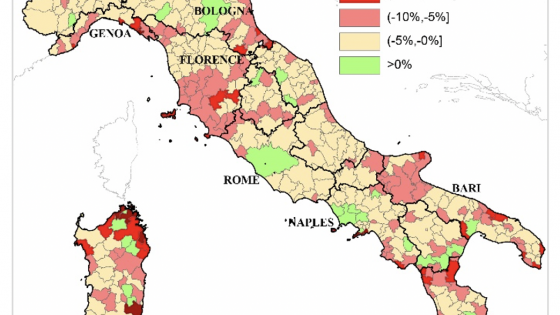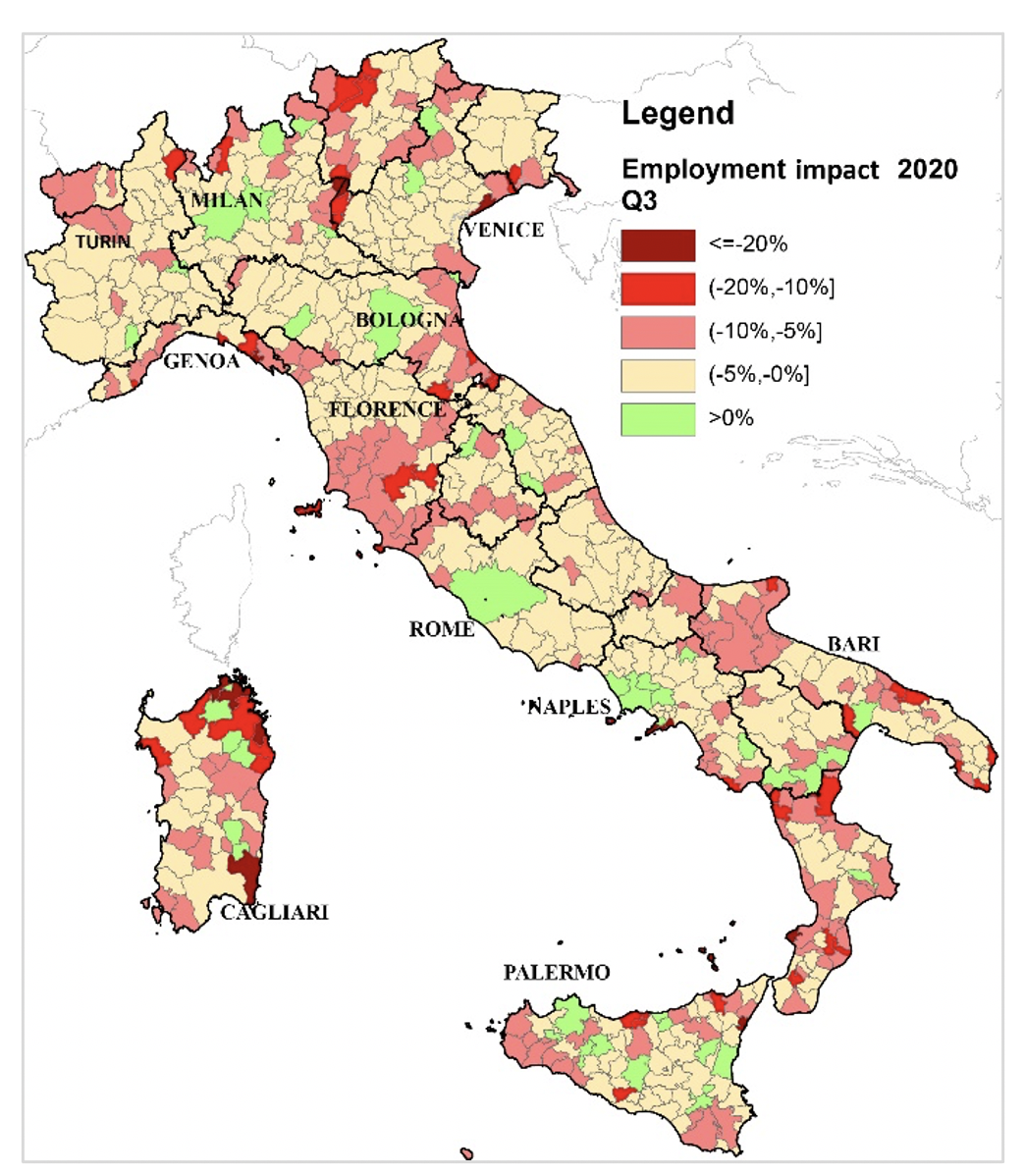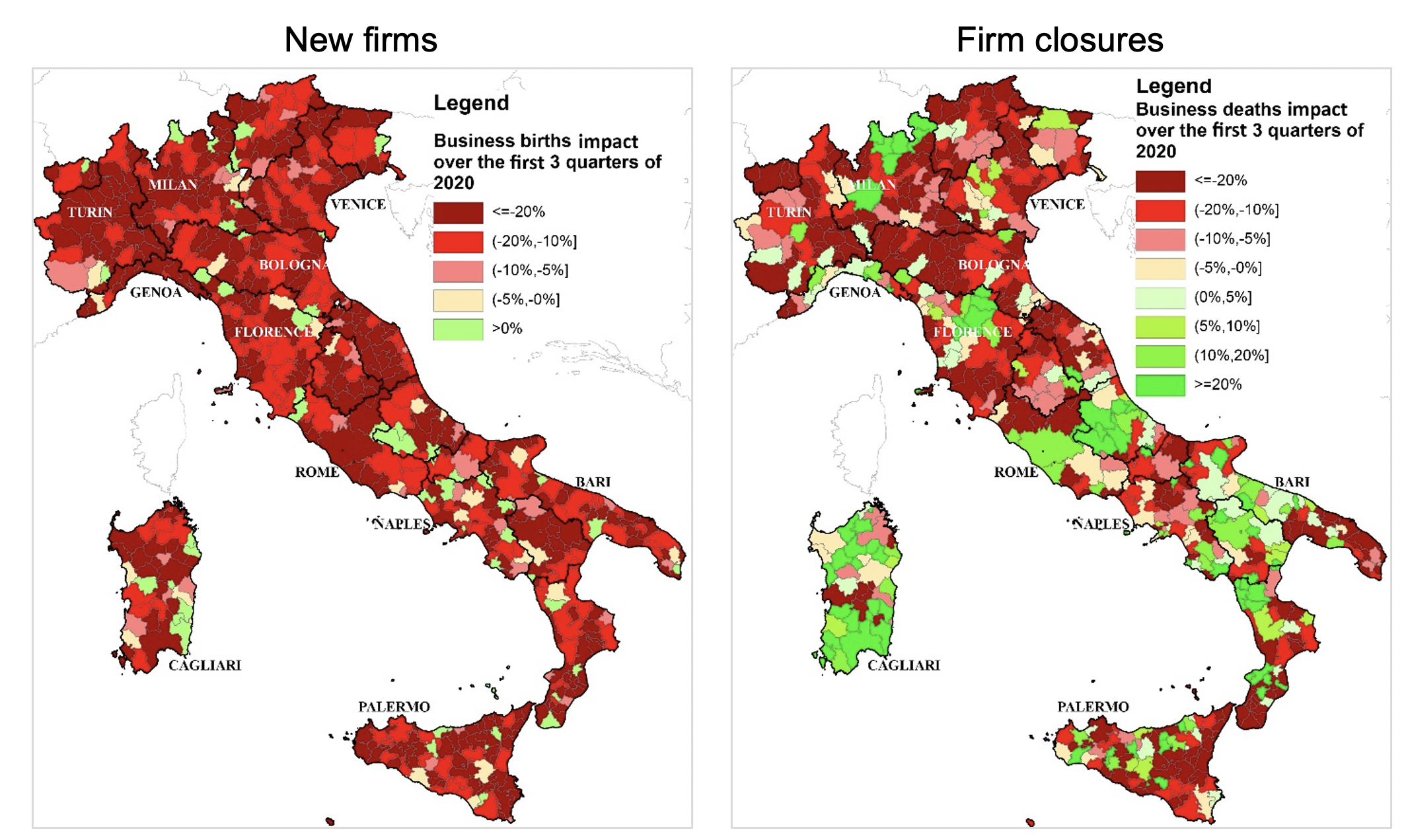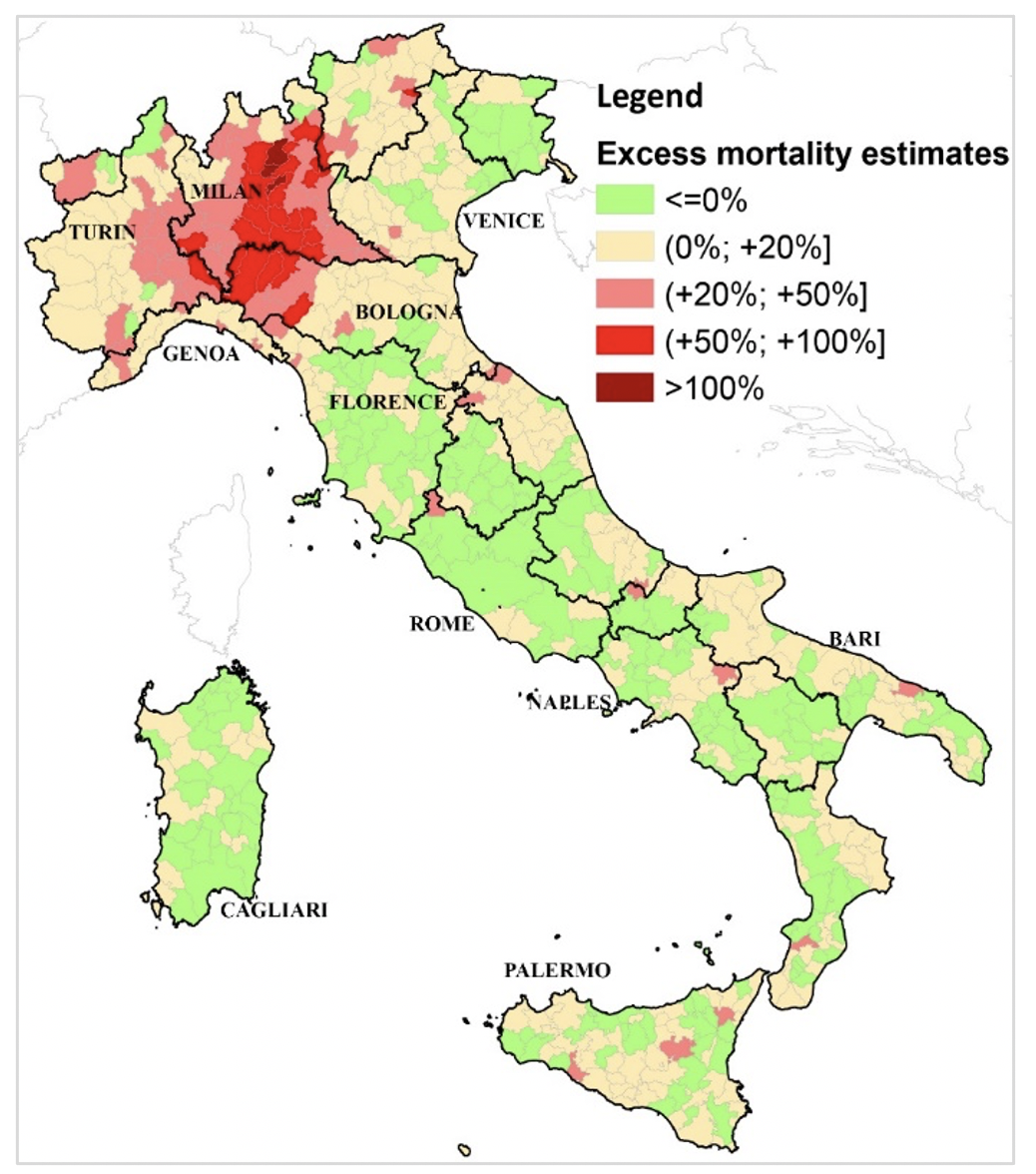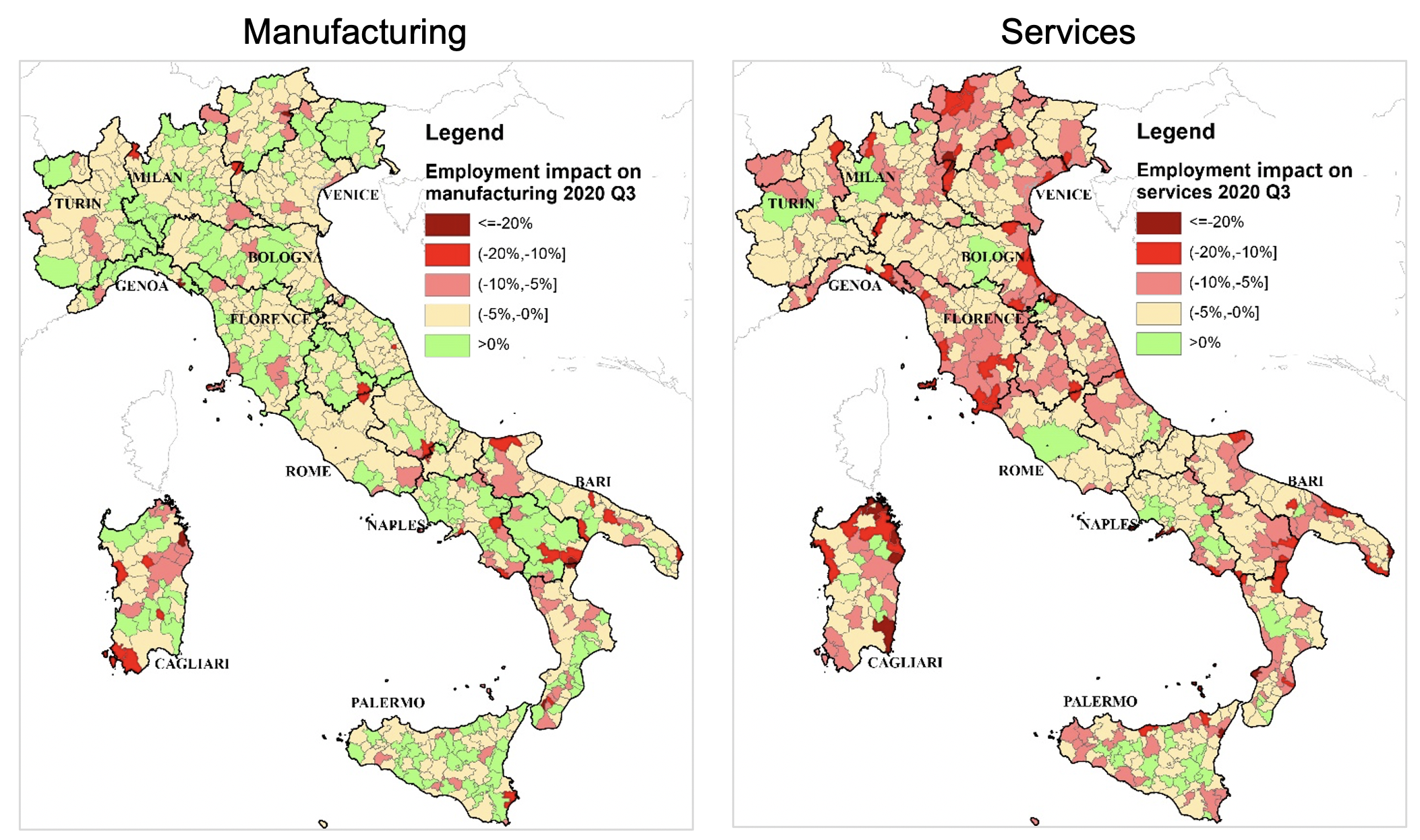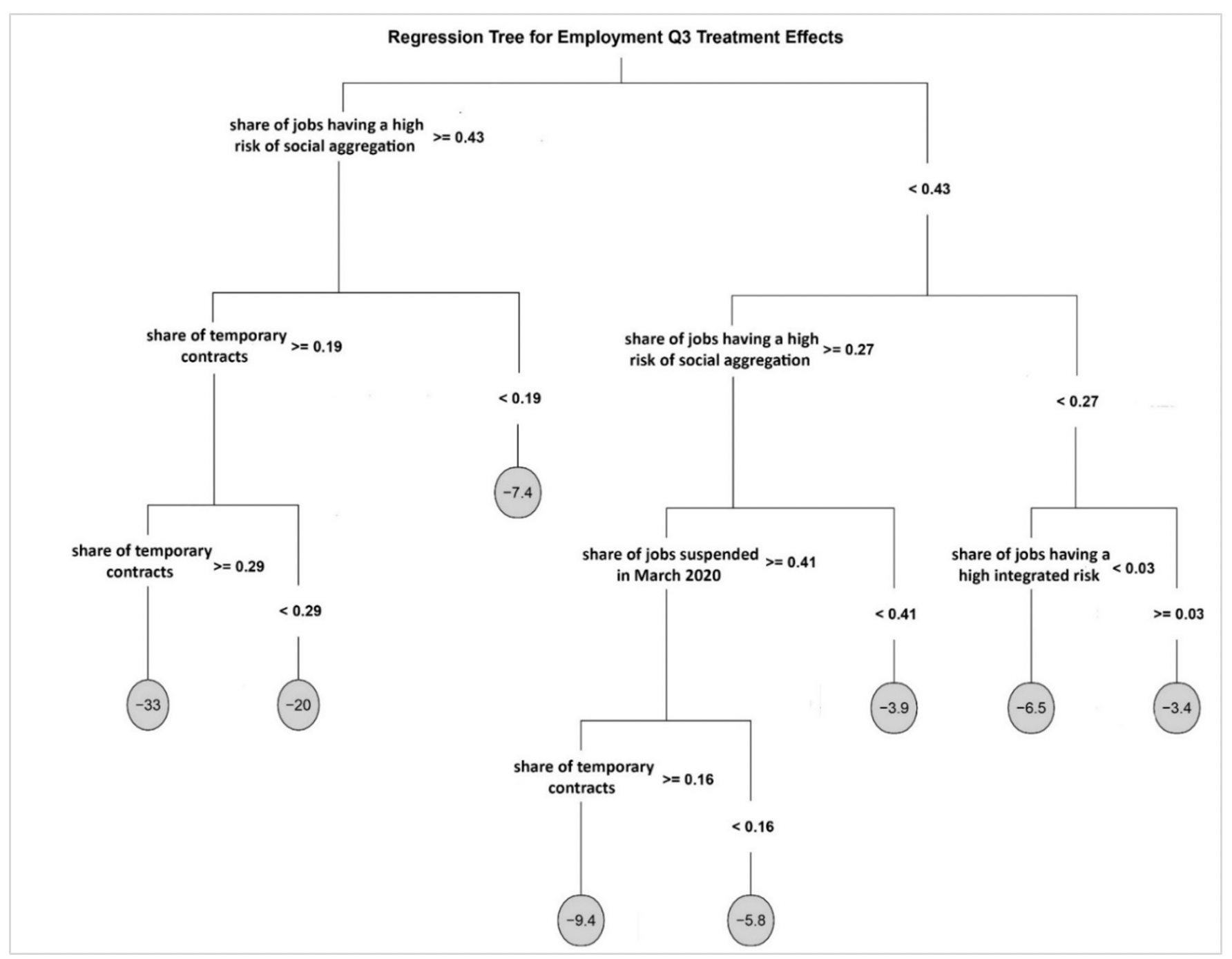As Italy is still in the grip of the second wave of the COVID-19 pandemic, the need for reliable quantifications of the real costs of the crisis has become pressing. Recent projections by the IMF suggest, at the aggregate level, an annual GDP drop of 10.6% (IMF 2020). The available evidence (Casarico and Lattanzio 2020) shows heterogeneous effects on labour market flows. Yet, empirical quantification of microeconomic impacts on local economies is still missing, mainly because of real-time data scarcity and econometric challenges related to the ubiquitous nature of the COVID-19 shock.
Gauging the COVID-19 impact with machine learning
To assess the economic impact of the COVID-19 shock, one should compare the observed outcomes with what would have happened if the pandemic had never occurred.1 The latter scenario is, of course, unobservable. Similarly, one cannot compare local economies hit by the shock with those not affected by it – the national lockdown simultaneously involved the closure of workplaces and economic activities across the entire Italian territory, thus preventing the possibility of using econometric techniques such as the synthetic control method (Abadie et al. 2010), which require the availability of ‘untreated’ control units.
For this reason, a common way to gauge the magnitude of the economic shock is a before-after analysis of the changes between the trend of a given outcome (say, firm entries) in 2020 (after the pandemic’s arrival) and the pre-pandemic average figures of the past years. For instance, under this intuitive approach, if 15,000 new firms were started every year on average in Rome between 2017 and 2019, but only 9,000 in 2020, then the causal effect of COVID-19 in Rome would be a decrease of 6,000 new firms. The underlying assumption is that, without the pandemic, the trend would have been flat, i.e. the number of new firms would have remained constant.
In our recent work (Cerqua and Letta 2020), we adopt instead a data-driven approach to establish causality: the machine learning control method (MLCM) for counterfactual building, first proposed by Varian (2016) and recently implemented by, among others, Benatia and de Villemeure (2020), Burlig et al. (2020), and Cerqua et al. (2020). Specifically, we build a comprehensive, balanced panel of all 610 Italian Local Labour Markets (LLMs)2 from 2014 Q3 to 2020 Q3, which includes information on the industrial structure, population density, economic variables, and firm demographic trends, and apply a complex nonlinear machine learning (ML) algorithm, the random forest (Hastie et al. 2009). We show that, thanks to the random forest’s ability to fully exploit data information and effectively predict out-of-sample, our approach delivers much more accurate predictions of economic outcomes in ‘ordinary’ years than the before-after standard metric.
We employ this algorithm on the pre-2020 data to predict, for each LLM, what the 2020 economic outcomes would have been in a counterfactual scenario in which the COVID-19 shock never happened. This allows us to generate an artificial control group and compare the observed post-pandemic data with the ML-predicted values. The difference between the two is the overall net effect of the COVID-19 generalised disruption.
Local economic impacts
The results of this counterfactual analysis are presented in Figures 1 and 2. The employment and firm maps consistently point to an unambiguous conclusion: the effects of the crisis have been, to date, dramatically uneven across the Italian territory. For all outcomes, there is no evident geographic clustering or spatial pattern along the North-South axis: the hardest-hit local areas are often geographically close, if not contiguous, to more resilient LLMs.
Figure 1 Employment impact, 2020 Q3
Figure 2 Firm demographic impacts (2020 Q1-Q3)
This local unevenness is averaged away at the aggregate level, where we detect a generalised drop in firm entries, but only moderate decreases in employment levels and firm closures. Besides, these impacts, especially those concerning employment, are net of the emergency measures adopted by the Italian government (such as the layoff freeze). It is thus plausible that, without these protective measures, local effects would have been much more severe, consistent with the findings of other recent analyses (Viviano 2020).
Understanding heterogeneity
Is this geographic distribution consistent with the epidemiological spread of the first wave? No, as shown in Figure 3: there is a lack of any significant spatial correlation between the economic and epidemiological patterns of the crisis, at least until the end of the third quarter of 2020.
Figure 3 Excess mortality estimates, 21 February 2020 to 30 September 2020
Notes: Excess mortality estimates are from Cerqua et al. (2020)
Where does such a striking heterogeneity then come from? Part of the answer is sectoral specialisation. Figure 4 shows employment effects disaggregated by sector: manufacturing versus services. As one would expect, local economies that are more dependent on services have been more greatly affected than those specialised in manufacturing, which includes the productive activities deemed as ‘essential’ for the functioning of the country’s economic system that were excluded from the national shutdown.
Figure 4 Employment impact by sector, 2020 Q3
We then further investigate what are the LLM features that matter the most in explaining the local inequality of impacts, other than sectoral specialisation. To this end, we collect a vast array of local-level features, including the epidemiological impact of COVID-19, the dependency ratio, the share of jobs having a high risk of social aggregation/integrated risk,3 the share of short-term contracts, the share of jobs in economic activities suspended during the lockdown, three proxies of mobility, and other economic variables.
Via an association analysis performed on the full LLM sample, whose results are depicted in the regression tree of Figure 5, we document that the heterogeneous employment effects are mainly associated with differences in social aggregation and labour market characteristics.
Figure 5 Regression tree on employment impact, 2020 Q3
Exposure to high aggregation risk seems to be a primary discriminant of impacts across LLMs with different shares of ‘workers at risk’ (Barbieri et al. 2020). Other important predictors are variables capturing pre-existing labour market fragilities. For instance, the tree predicts that LLMs with a share of jobs having a risk of aggregation equal to or higher than 43% and a share of temporary contracts equal to or higher than 29% will experience a 33% drop in employment.
Implications
Leading scholars noted early that the economic crisis caused by the COVID-19 would play out unequally across areas (Overman 2020), and that national top-down policies will be insufficient to lead the recovery (Bailey et al. 2020). Our findings corroborate these views, and suggest that, as the pandemic is unfolding unevenly at the local level, it is essential to adopt a place-based approach in the policy response to the crisis. The risk of ignoring such inequalities is that the pandemic will deepen pre-existing local labour market vulnerabilities and further exacerbate territorial disparities, possibly even leading to bifurcations in development paths.
Therefore, in light of the current debate on the allocation of the forthcoming resources earmarked by the EU under the Next Generation EU initiative, it would be wise for policymakers ‒ in Italy as elsewhere in Europe ‒ not to overlook the local dimension of this unprecedented crisis.
Authors' note: The views expressed here are those of the authors and do not necessarily reflect those of the institution they belong to.
References
Abadie A, A Diamond and J Hainmueller (2010), “Synthetic control methods for comparative case studies: Estimating the effect of California’s tobacco control program”, Journal of the American Statistical Association 105(490): 493–505.
Bailey D, J Clark, A Colombelli, C Corradini, L De Propris, B Derudder and Kemeny T (2020), “Regions in a time of pandemic”, Regional Studies 54(9): 1163–1174.
Barbieri T, G Basso and S Scicchitano (2020), “Italian Workers at Risk During the Covid-19 Epidemic”, GLO Discussion Paper Series No. 513.
Benatia D and E B de Villemeur (2019), “Strategic reneging in sequential imperfect markets”, CREST Working Papers 2019-19.
Burlig F, C R Knittel, D Rapson, M Reguant and C Wolfram (2020), “Machine learning from schools about energy efficiency”, Journal of the Association of Environmental and Resource Economists 7(6): 1181–1217.
Casarico A and S Lattanzio (2020), “The heterogeneous effects of COVID-19 on labor market flows: Evidence from administrative data”, COVID Economics 52: 152–174.
Cerqua A and M Letta (2020), “Local economies amidst the COVID-19 crisis in Italy: A tale of diverging trajectories”, COVID Economics 60: 142-171.
De Grauwe P and Y Ji (2020), “A tale of three depressions”, VoxEU.org, 24 September.
Cerqua A, R Di Stefano, M Letta and S Miccoli (2020), “Local mortality estimates during the COVID-19 pandemic in Italy”, GSSI Discussion Paper Series in Regional Science & Economic Geography No.6/2020.
Hastie T, R Tibshirani and J Friedman (2009), The Elements of Statistical Learning: Data Mining, Inference, and Prediction, Springer Science & Business Media.
IMF (2020), World Economic Outlook, October.
Overman H (2020), “How the UK government should respond to the unequal local economic impacts of COVID-19”, VoxEU.org, 22 April.
Varian HR (2016), “Causal inference in economics and marketing”, Proceedings of the National Academy of Sciences 113(27): 7310–7315.
Viviano E. per la Banca d’Italia, “Preliminary estimates of the labor market effects of some support measures”, Banca d’Italia, November 2020 (Only in Italian).
Endnotes
1 A clarification: by ‘COVID-19 shock’, we mean the economic shock, i.e. we refer not only to the epidemiological spread of the virus per se, but also to the national lockdown and the restrictive measures targeting economic activities that were adopted to contain the health crisis. This series of events jointly resulted in major negative supply and demand shocks, which then interacted and amplified each other (De Grauwe and Ji 2020).
2 Italian LLMs are determined following criteria similar to those used to define Metropolitan Statistical Areas in the US or Travel to Work Areas in the UK.
3 Activities at high integrated risk are those associated with the risk of coming into contact with sources of contagion at work, especially those connected to work processes (e.g. human health services, sewerage, public administration, and defence), while activities at high risk of social aggregation are those that involve contact with other subjects in addition to the company’s workers (e.g. catering, entertainment, hospitality).
